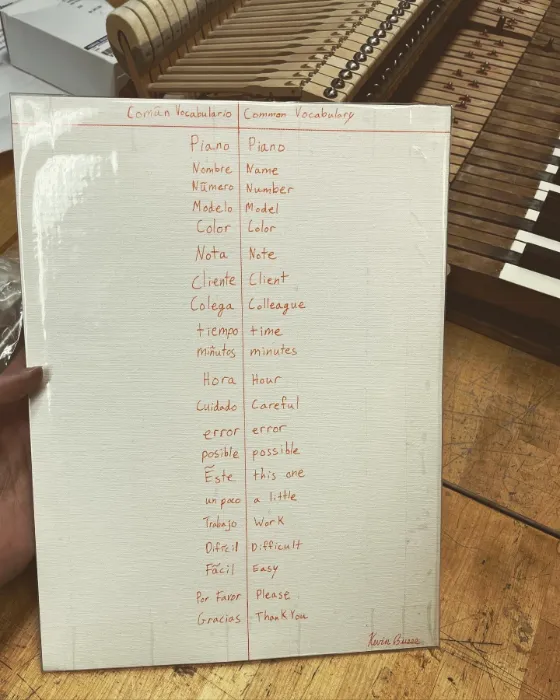Best Way to Quickly Learn Spanish as a Piano Tuner

Get a jump start with learning Spanish effectively in a Piano workshop by reviewing the 6 best ways to learn quickly.
After becoming a successful technician in New York City, I found that a fun way to enrich my work experience was to take the first steps of learning Spanish this last year.
How to learn Spanish as a Piano Tuner?
#1 Use simple, similar, and select few words easily understood in both languages
At the outset of my Spanish language learning journey, I put together all of the Spanish words that sounded most similar to words in English on one sheet of card stock paper.
This made it quick and easy to learn and remember new words in a new language (to me) commonly used in the setting of a piano workshop.
*While learning, I used a standard translation app to help confirm these frequently used vocabulary words.
Similar Vocabulary for Pianos in English and Spanish
Common Phrases for Pianos in English and Spanish
I also wrote down commonly used phrases I found helpful to the Piano workplace, which is an easy way to get started.
Although, these words are not as similar as they are in the vocabulary above, there is a mix of similar and new vocabulary words that are useful.
#2 Listen to "Learn Spanish with Paul Noble for Beginners - Complete Course"
Forget all of the other free courses that you have. This is the absolute best audiobook I found for learning Spanish, which is the fastest way to gain lasting fundamentals.
No need to memorize. No worrying about keeping up. No stress.
It helps to have some "turf" in the learning process before you begin to try to talk to those who already know Spanish fluently.
It costs one credit if you already have an Audible subscription.
#3 Start to talk to Native Speakers in your workplace with a select few words
Learning a foreign language is scary. The best thing I ever did was to speak a few words with my Spanish speaking colleagues only AFTER I listened to more than half of the course.
In my experience, I have found that most Spanish speakers are delighted when they realize that I know a word or two in Spanish.
Depending on how friendly you are with the Spanish speaker, they may be willing to help you learn Spanish every so often with everyday conversations.
This is by far the best way to get extra practice. (After step #1 & #2 ofcourse)
#4 Sign up on Duolingo and complete short courses each day
Right now, my DuoLingo streak is at 238 days. That's 238 of consecutive practice.
Now, keep in mind, it allows for streak "freezes." This is in case you completely miss a day, you won't lose all of your progress.
I have also invited friends to join the app so that I created an environment of people surrounding me who also participate in the language learning process. (albeit at a widely different pace)
#5 Set a destination trip to a Spanish-speaking countries
This may be out of the cards for many, however, I found that looking forward to a vacation at an inexpensive all-inclusive resort in a Spanish-speaking country is worth the extra motivation to do some of the hard work of staying consistent in learning a new language.
On my trip to Cancun, Mexico I was able to speak with all native language speakers in simple sentences after I surpassed my one year anniversary of learning Spanish.
#6 Cut out what doesn't work
I've tried a lot of different approaches with Spanish language learning.
What I noticed is that some things are less effective than others.
In my case, I avoid:
Radio listening - Not as effective as the Audible in the car (mentioned above)
Spanish Music - I love Spanish music and Spanish culture, but the rate of learning is comparatively slow
Audiobooks/podcasts that aren't that great - Don't waste time on something that doesn't feel right
Spanish Classes - This may be helpful, but it's not for me.
spanish podcasts - I don't comprehend enough to learn just from podcasts
After following these tips, enjoy your new language skills! May the world be your oyster!
Related:
How to Become an RPT in Less than 1 Year
2 Powerful and Easy Services to Make a Website as a Tuner
Technician Gear, Tools, Machinery
Best SwissGear Work Backpack Tool Bag Review
Nova Voyager DVR Dril Press Review By A Piano Technician
Best Roll Up Screwdriver Set PB Swiss Tools
Best Piano Service Supplies For Hybrid And Electronic Repair
Best Tools To Use For The Piano Life Saver Dampp Chaser System




